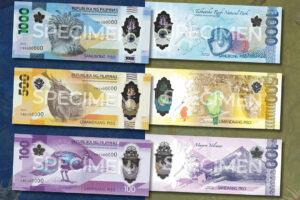
Limited quantity of new polymer notes out next week
The First Philippine Polymer Banknote Series is composed of the 1000-piso polymer banknote, as well as new polymer denominations: 500-, 100-, and 50-piso. — COURTESY OF THE BANGKO SENTRAL NG PILIPINAS
THE BANGKO SENTRAL ng Pilipinas (BSP) on Thursday unveiled its first series of polymer banknotes, which features the country’s protected and native species.
BSP Governor Eli M. Remolona, Jr. presented the Philippine polymer banknote series to President Ferdinand R. Marcos, Jr. in a ceremony in Malacañang.
The polymer series includes new denominations of P50, P100 and P500, as well as the P1,000 bill, which was first introduced in April 2022.
The new polymer bills are “smarter” than their paper counterparts because they have advanced anti-counterfeiting features and a smaller carbon footprint, Mr. Remolona said.
BSP Assistant Governor Mary Anne Lim told reporters on the sidelines of the ceremony that the new polymer notes will be available in “limited” quantities in the greater Metro Manila area by Dec. 23.
In a separate statement, the BSP said the new denominations of the polymer series may initially be withdrawn over the counter in banks. The P500 and P100 polymer notes will later be available through automated teller machines (ATMs).
Mr. Remolona said the polymer series aims to raise awareness of endangered species, as well as “serves as a symbol of Filipino identity, and fosters national pride.”
The BSP in April 2022 introduced the new P1,000 polymer note, which featured the sampaguita and the Philippine eagle.
The new P500 note features the Visayan spotted dear, a creature found only in the rainforests of Panay and in Negros, and the orchid called acanthophippium mantinianum.
The new P100 note features the Palawan peacock-pheasant and the orchid called Ceratocentron fesseli, while the P50 polymer showcases the Visayan leopard cat and flower called Vidal’s lanutan.
Mr. Remolana said the new notes are cleaner “because viruses and bacteria do not survive on polymer as long as they do on paper.”
The new bills are also stronger “because they last longer than their paper counterparts.”
In his speech, Mr. Marcos said the first Philippine polymer banknote series marks a historic moment for the country.
“It builds on the success of the one-thousand-peso polymer note introduced in April of 2022 and aligns with the global best practice of updating currency features every 10 years,” he added.
Mr. Marcos said over 40 countries including Australia, Canada, the United Kingdom, and Singapore have already adopted polymer banknotes “due to their proven benefits.”
Mr. Marcos said unlike paper bills, which wear out after about a year and a half, “polymer banknotes can last up to seven and a half years — five times longer.”
The new polymer bills are a departure from the paper notes that feature Philippine heroes.
The Philippines is becoming an increasingly cashless economy “but there will long be a need for cash especially for people and businesses with the least access to technology,” Mr. Remolana said.
“It is especially for them that we are adding these polymer notes to our currency.” — Kyle Aristophere T. Atienza


